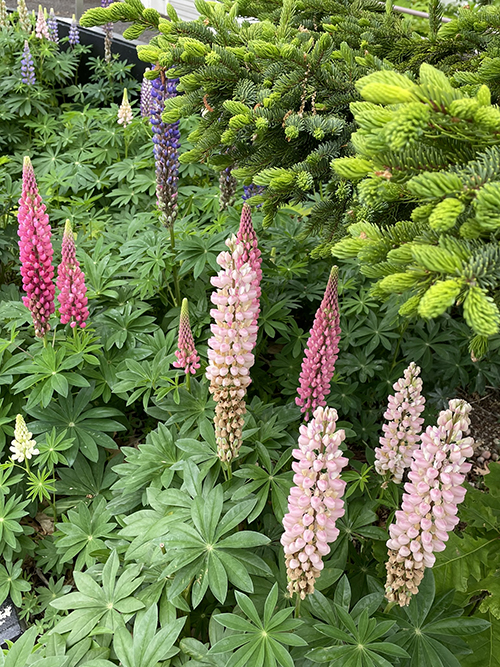
写真はきのう久しぶりにちょっとだけの「散歩」をしたら、さっそく路傍から目を楽しませてくれたルピナス(昇り藤)。この花は北海道自生の品種ではなく明治以降の開拓の過程で、ヨーロッパから導入された花。っていうか、それが目的ではなく付随的に入ってきたとされる。どんなところにも咲く、旺盛な繁殖力で知られて、北海道から本州地域にも広がっているとされる。
こういう品種の扱い方というのは「園芸」の世界とか「作庭・造園」など管理された美感の世界からは、いわば邪魔者扱いされるのではないか。一方ではわたしのような北海道ネイティブの人間からすると、こういった「野の美感」の代表のような存在で、ちょうどすべての草花が一斉に咲きほころび始める北海道らしい春を代表するようなものと受け止めている。
で、日本庭園美の様式的「作庭」という文化からは、いちばん遠い「北の自然美」にも通じているかなぁと改めて目を見張らされた。
健康面でのアラートがいろいろ出てきて、思うように散歩に行けないのだけれど、わたしの場合、家のまわりに庭をつくって緑を楽しむというよりも、ちょっと散歩に出掛ければ、明治期にアメリカ人都市計画家たちが北海道らしい自然をそのままに保存させてくれた円山公園緑地などが、広大に広がっていて、そこでアイヌの人たちのソウルフードをその球根部分に生成させる「オオウバユリ」の発芽からみごとな開花までを毎年のように楽しんでいる。イキモノとしてその生成変容していく様子は、まことに植物の「叙事詩」をリアルタイムで感応させてくれるのだ。
さらにこのようなルピナスはまことにゲリラ的にあらゆる路傍に突然出現して、美を主張している。
そういう自然との対話をしている人間からすれば、いかにも審美眼の極地のような造園・作庭に極限的価値感を求めたいという心理・気分にはなれない。
そういう美感世界を否定はしないし、それはそれで素晴らしいと思うけれど、さりとて、やはり必死に北海道の自然の野の中で、いのちをつないでいるその美を祝福したくなるのが人情。
ルピナスはこの地に来て以来、たとえば道東のオホーツク人遺跡という鄙の地でも、路傍を彩っている。このようなあるがままの自然の美が、ちょっと目を転じたらあらゆる場所で生き延びているのが北海道なのだと思う。だから塀で囲って「自分だけの」鑑賞世界に閉じ込めて究極の美を誇る、というような作庭の「匠」技のようなものに同意しにくいのかも知れない。
一昨日も北海道的な自然林と対話するような外部環境を整えている事例を見ていた。そういう「作庭」としては自然なままの植生を受け入れて、枝の下の方を払って眺望性を確保したり、自然のままの芝のなかに徐々に生成される苔を丹念に保護したりというような「作庭」をされていた。
納得と同意の気分を強く持っていた。
English version⬇
The Natural Beauty of Hokkaido and the Beauty of Japanese “Sakutei” Gardens
A continuation of the garden culture theory. It is not “bloom in the field, evening primrose,” but a variety of species are blooming in Hokkaido. The intensity of life and self-assertion of this natural beauty is intoxicating. The garden is a place of beauty and beauty.
The photo is of a lupine (Ascending Wisteria) that immediately delighted my eyes from the roadside when I took a short “walk” for the first time in a while yesterday. This flower is not native to Hokkaido, but was introduced from Europe in the process of cultivation after the Meiji period. It is said to have been introduced incidentally, rather than for that purpose. Known for its vigorous fertility, which allows it to bloom anywhere, it is said to have spread from Hokkaido to the Honshu region.
This kind of treatment is considered an obstacle in the world of “horticulture,” “gardening,” and “landscaping,” where the beauty of the plants is controlled. On the other hand, to a native of Hokkaido like myself, they are representative of the “beauty of the wild,” and I see them as representing the spring season in Hokkaido, when all the plants and flowers begin to bloom and bloom at once.
I was struck once again by the fact that the stylistic “Sakutei” culture of Japanese garden beauty is also connected to the “natural beauty of the north,” which is the furthest thing from the culture of Japanese garden beauty.
I have a number of health alerts that prevent me from going for walks as much as I would like, but in my case, rather than creating a garden around my house to enjoy the greenery, I just go for a short walk and find the Maruyama Park green space, where American urban planners in the Meiji period preserved the natural beauty that is typical of Hokkaido, There, I enjoy watching the “Oubayuri,” which produces the bulbous part of the Ainu people’s soul food, from germination to beautiful blooming, as I do every year. The way the plant is formed and transformed as an inanimate object is truly an “epic poem” of plants in real time.
In addition, lupines like this one appear suddenly and guerrilla-like on every roadside, asserting their beauty.
For those of us who interact with nature in this way, it is impossible for us to feel the urge to seek extreme values in landscaping and gardens that seem to be the ultimate in aesthetics.
I do not deny the beauty of such a world, and I think it is wonderful in its own way, but I still want to celebrate the beauty that is desperately holding on to life in the wilds of nature in Hokkaido.
Since its arrival here, lupine has been gracing the roadsides of remote Okhotsk sites in the east of Hokkaido, for example. I believe that this kind of natural beauty survives in Hokkaido in all kinds of places. Perhaps that is why it is difficult to agree with the “artisanal” techniques of garden design, such as enclosing the garden with a fence and confining it to one’s own “private” world of appreciation and pride in its ultimate beauty.
The day before yesterday, I was looking at an example of an external environment that interacts with a natural forest in a Hokkaido-like setting. In this kind of “garden design,” they accepted the vegetation in its natural state, removed the lower part of the branches to secure the view, and carefully protected the moss that gradually formed in the natural grass.
I was in a strong mood of acceptance and agreement.
Posted on 6月 7th, 2024 by 三木 奎吾
Filed under: 「都市の快適」研究







コメントを投稿
「※誹謗中傷や、悪意のある書き込み、営利目的などのコメントを防ぐために、投稿された全てのコメントは一時的に保留されますのでご了承ください。」
You must be logged in to post a comment.